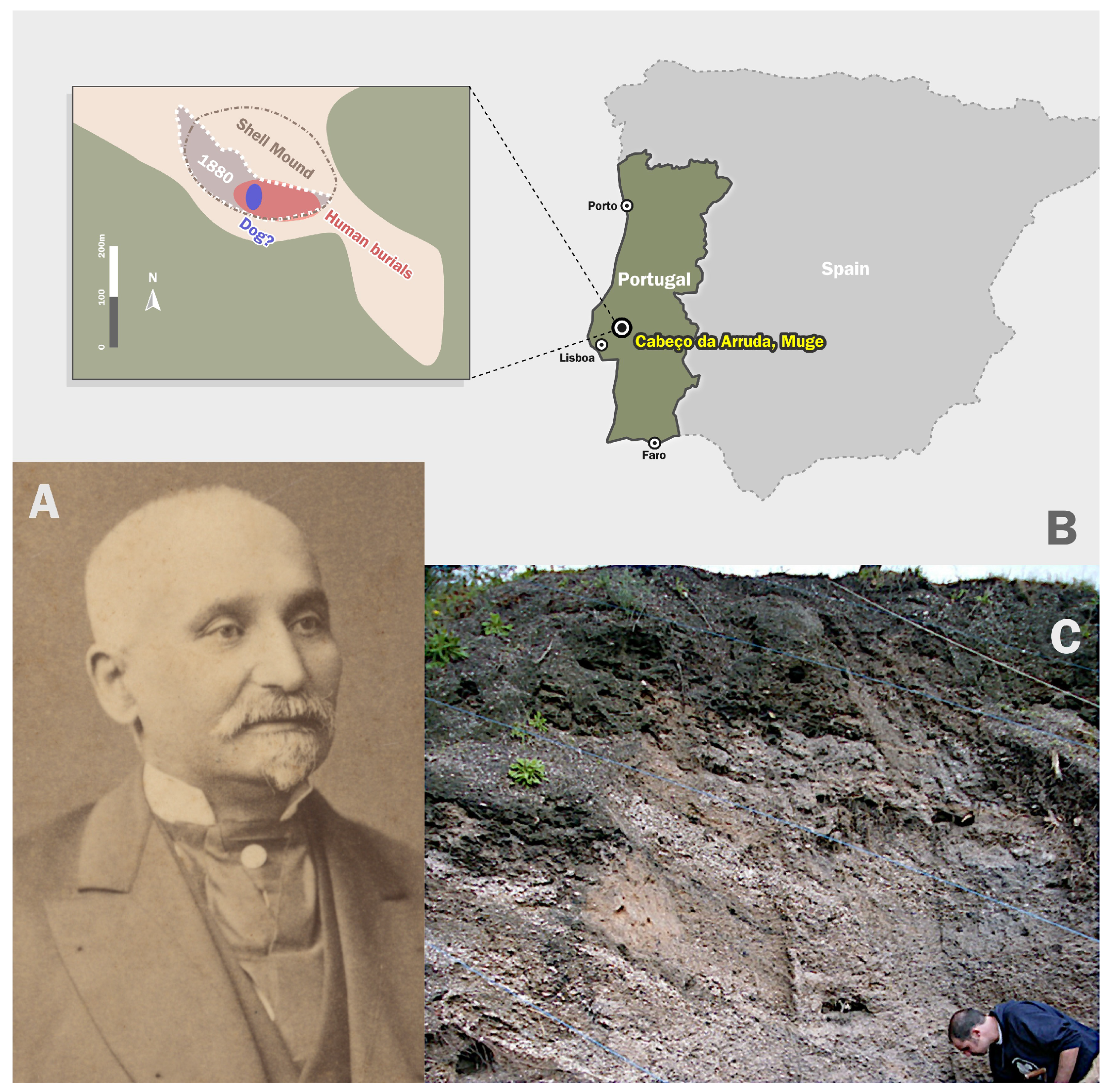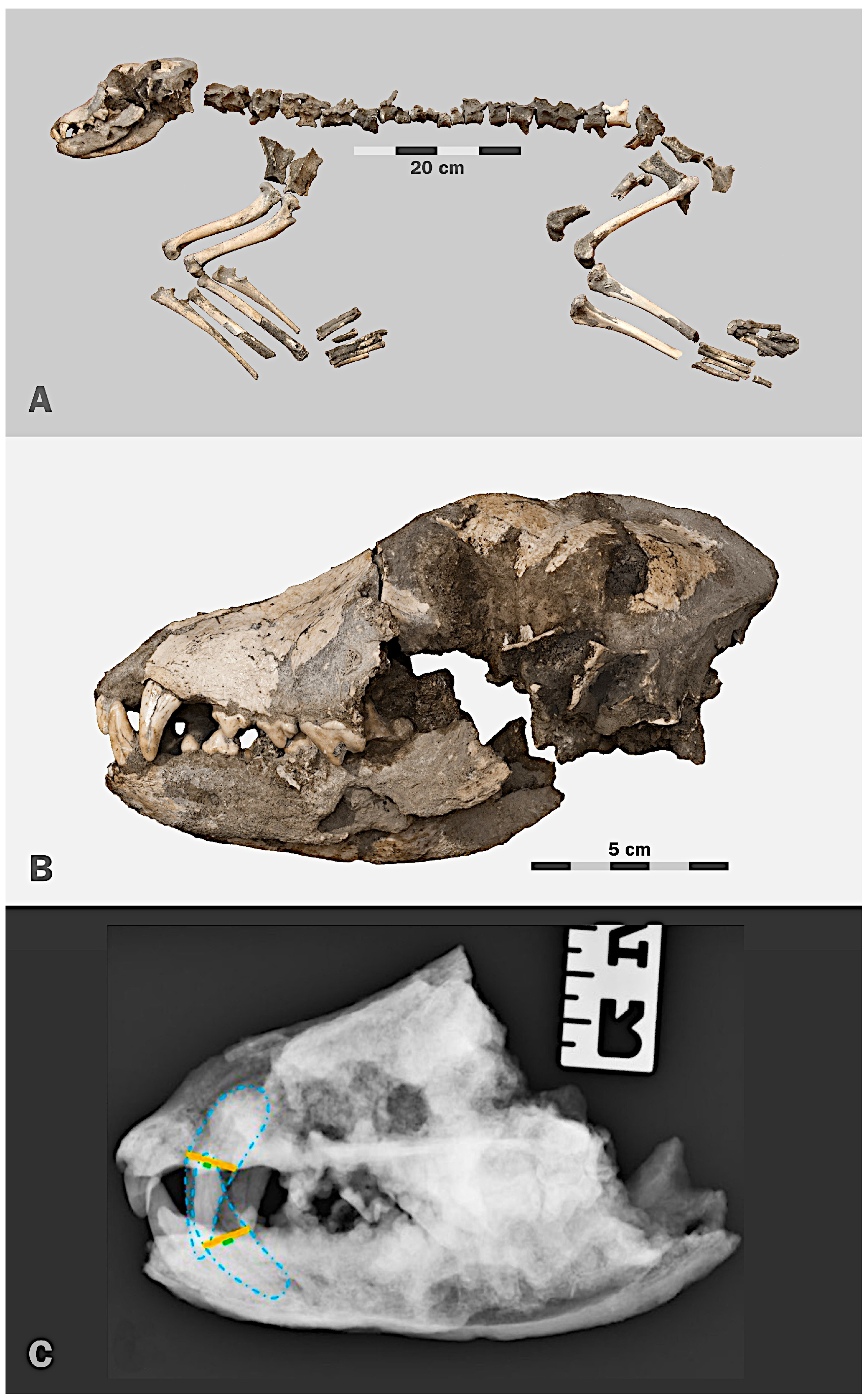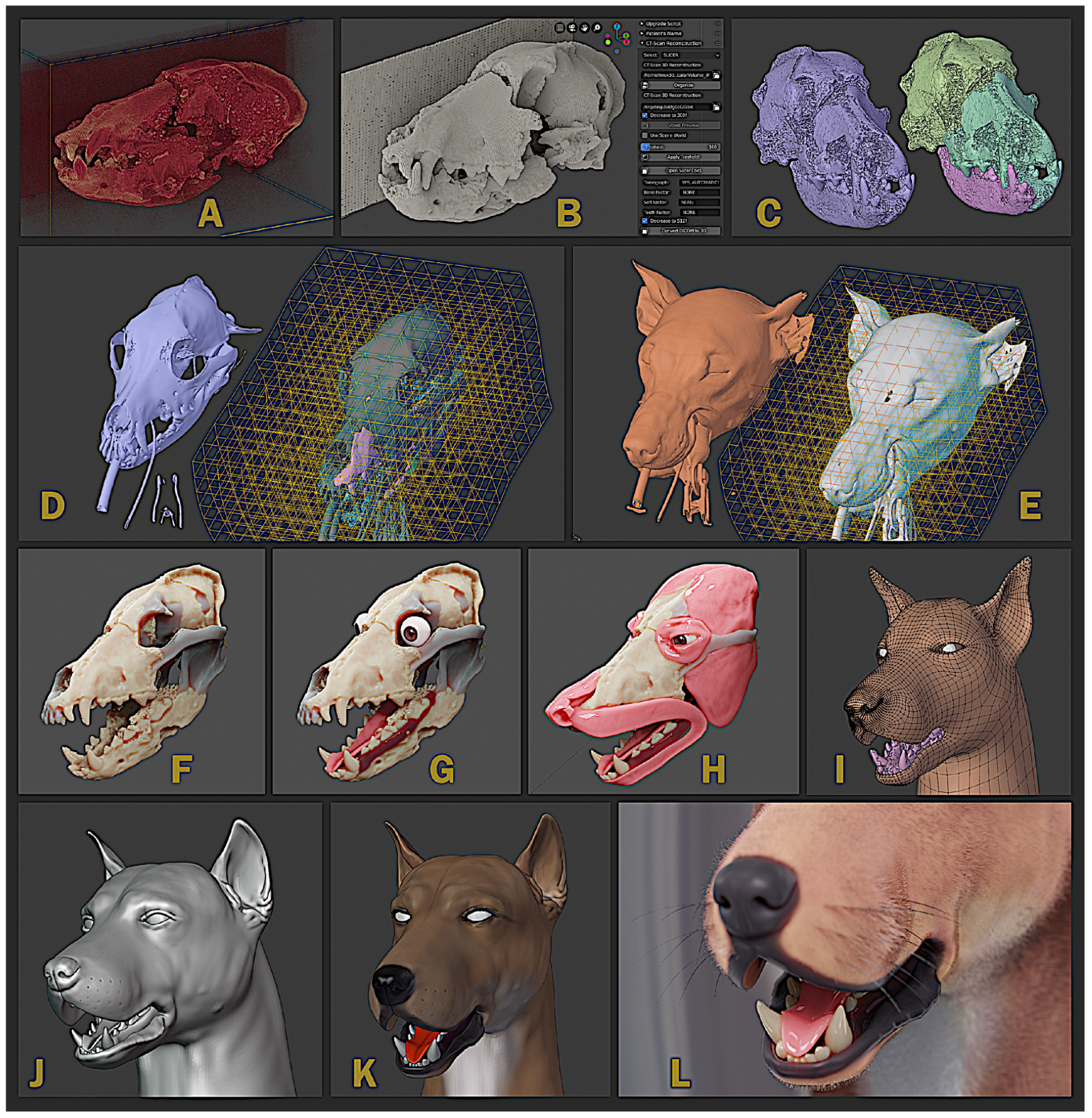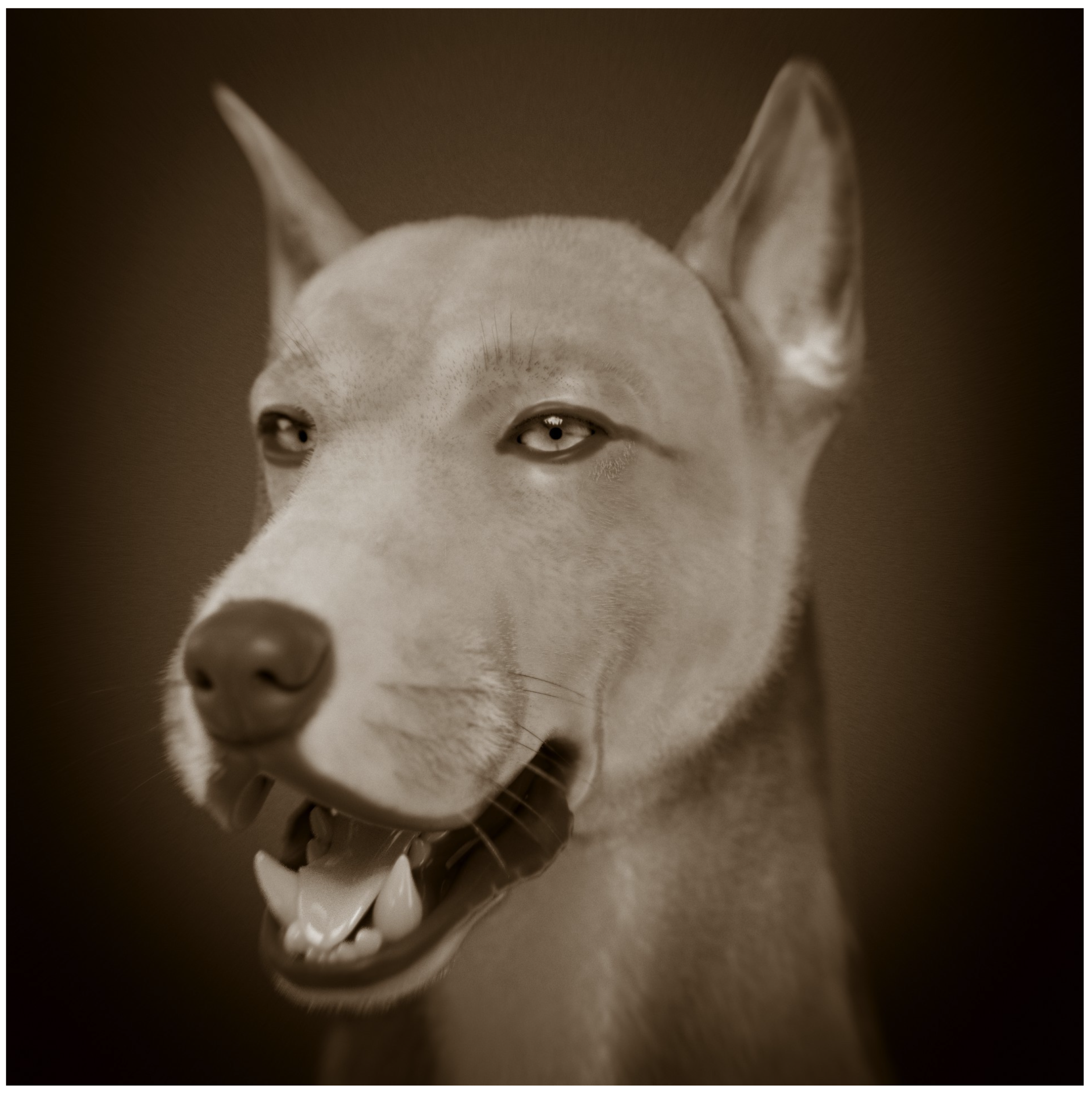The Facial Reconstruction of a Mesolithic Dog, Muge, Portugal
Abstract
:1. Introduction
2. Materials and Methods
2.1. Sample
2.2. Computed Tomography (CT) Acquisition
2.3. Virtual Tridimensional Reconstruction of the Skull
3. Results and Discussion
4. Conclusions
Author Contributions
Funding
Institutional Review Board Statement
Informed Consent Statement
Data Availability Statement
Acknowledgments
Conflicts of Interest
References
- Ribeiro, C. Note sur le terrain quaternaire du Portugal. Bull. Société Géologique Fr. 1867, 692–717. [Google Scholar]
- Cardoso, J.L. Primórdios dos estudos pré-históricos em Portugal: Os concheiros mesolíticos de Muge (Salvaterra de Magos) e os seus exploradores. In Memoriam. Estudos de Homenagem a António Augusto Tavares; Cardoso, J.L., Sales, J.C., Eds.; Universidade Aberta: Lisbon, Portugal, 2018. [Google Scholar]
- Detry, C.; Cardoso, J.L. On some remains of dog (Canis familiaris) from the Mesolithic shell-middens of Muge, Portugal. J. Archaeol. Sci. 2010, 37, 2762–2774. [Google Scholar] [CrossRef]
- Cunha, E.; Cardoso, F. New data on Muge shell middens: A contribution to more accurate numbers and dates. Muge Estud. Arqueol. 2003, 1, 171–184. [Google Scholar]
- Roksandic, M. Analysis of burials from the new excavations of the sites Cabeço da Amoreira and Cabeço da Arruda (Muge, Portugal). In Do Epipalaeolítico Ao Calcolítico Na Península Ibérica; Bicho, A.H.V., Ed.; Universidade do Algarve: Faro, Portugal, 2006; pp. 43–54. [Google Scholar]
- Pires, A.E.; Detry, C.; Chikhi, L.; Rasteiro, R.; Amorim, I.R.; Simões, F.; Matos, J.; Petrucci-Fonseca, F.; Ollivier, M.; Hänni, C.; et al. The curious case of the Mesolithic Iberian dogs: An archaeogenetic study. J. Archaeol. Sci. 2019, 105, 116–129. [Google Scholar] [CrossRef]
- Cardoso, J.L. (Ed.) Carlos Ribeiro (1813–1882) geólogo e arqueólogo. Homenagem da Câmara Municipal de Oeiras e da Academia das Ciências de Lisboa nos 200 anos do seu nascimento. In Estudos Arqueológicos de Oeiras; Câmara Municipal de Oeiras: Oeiras, Portugal, 2013; Volume 20, 800p. [Google Scholar]
- Cardoso, J.L.; Rolão, J.M. Prospecções e escavações nos concheiros mesolíticos de Muge e de Magos (Salvaterra de Magos): Contribuição para a história dos trabalhos arqueológicos efectuados. Estud. Arqueol. Oeiras 2000, 8, 83–240. [Google Scholar]
- Boudadi-Maligne, M.; Mallye, J.-B.; Langlais, M.; Barshay-Szmidt, C. Des restes de chiens magdaléniens à l’abri du Morin (Gironde, France). Implications socio-économiques d’une innovation zootechnique. Paléo 2012, 23, 39–54. [Google Scholar] [CrossRef]
- Baumann, C.; Pfrengle, S.; Münzel, S.C.; Molak, M.; Feuerborn, T.R.; Breidenstein, A.; Reiter, E.; Albrecht, G.; Kind, C.-J.; Verjux, C.; et al. A refined proposal for the origin of dogs: The case study of Gnirshöhle, a Magdalenian cave site. Sci. Rep. 2021, 11, 1–14. [Google Scholar] [CrossRef] [PubMed]
- Street, M.; Napierala, H.; Janssens, L. The late Palaeolithic dog from Bonn-Oberkaassel in context. In The Late Glacial Burial from Oberkassel Revisited; Giemsch, L., Schmitz, R.W., Eds.; Verlag Philipp von Zabern GmbH: Darmstadt, Germany, 2015; pp. 253–274. ISBN 978-3-8053-4970-3. [Google Scholar]
- Pionnier-Capitan, M.; Bemilli, C.; Bodu, P.; Célérier, G.; Ferrié, J.-G.; Fosse, P.; Garcià, M.; Vigne, J.-D. New evidence for Upper Palaeolithic small domestic dogs in South-Western Europe. J. Archaeol. Sci. 2011, 38, 2123–2140. [Google Scholar] [CrossRef]
- Vigne, J.D. L’humérus de chien magdalénien de Erralla (Gipuzkoa, Espagne) et la domestication tardiglaciaire du loup en Europe. Munibe 2005, 51, 279–287. [Google Scholar]
- Nomokonova, T.; Losey, R.J.; McLachlin, K.; Bachura, O.P.; Gusev, A.V.; Kosintsev, P.A.; Fedorova, N.V.; Sablin, M.V. Age estimation of archaeological dogs using pulp cavity closure ratios. J. Archaeol. Sci. 2020, 123, 105252. [Google Scholar] [CrossRef]
- Taylor, K.T. Forensic Art and Illustration; CRC Press: Boca Raton, FL, USA, 2000. [Google Scholar] [CrossRef]
- Wilkinson, C. The history of facial reconstruction. In Forensic Facial Reconstruction; Cambridge University Press: Cambridge, UK, 2004; pp. 39–68. [Google Scholar] [CrossRef]
- Moraes, C. OrtogOnBlender: Documentação Oficial. Brazil: Sinop/MT. 2020. Available online: http://www.ciceromoraes.com.br/doc/pt_br/OrtogOnBlender/index.html (accessed on 5 April 2022).
- Martínez-Labarga, C.; Carbone, R.; Ridolfi, V.; Parrino, M.; Vitali, S.; Bravi, L.; Rickards, O.; Falconi, M. Craniofacial reconstruction of Raphael Sanzio from Urbino: Face and features of a “mortal god”. Digit. Appl. Archaeol. Cult. Herit. 2021, 22, e00190. [Google Scholar] [CrossRef]
- Crockford, S.J.; Pye, C.J. Forensic reconstruction of prehistoric dogs from the northwest coast. Can. J. Archaeol./J. Can. D’Archéol. 1997, 21, 149–153. [Google Scholar]
- Martinez-Navarro, B.; Lucenti, S.B.; Palmqvist, P.; Ros-Montoya, S.; Madurell-Malapeira, J.; Patrocinio Espigares, M. A new species of dog from the Early Pleistocene site of Venta Micena (Orce, Baza Basin, Spain). Comptes Rendus Palevol 2021. [Google Scholar] [CrossRef]
- The Guardian. Neolithic Dog Reveals Tales behind Orkney’s Monuments. The Guardian. 2018. Available online: https://www.theguardian.com/uk-news/2019/apr/13/neolithic-dog-reveals-tales-behind-orkney-monuments (accessed on 22 April 2022).
- Subsol, G.; Quatrehomme, G. Automatic 3D facial reconstruction by feature-based registration of a reference head. In Computer-Graphic Facial Reconstruction; Clement, J.G., Marks, M.K., Eds.; Academic Press: Cambridge, MA, USA, 2005; Volume 5, pp. 79–101. [Google Scholar]
- Gietzen, T.; Brylka, R.; Achenbach, J.; Zum Hebel, K.; Schömer, E.; Botsch, M.; Schwanecke, U.; Schulze, R. A method for automatic forensic facial reconstruction based on dense statistics of soft tissue thickness. PLoS ONE 2019, 14, e0210257. [Google Scholar] [CrossRef] [PubMed]
- Bezzi, L.; Moraes, C. Archaeological forensic facial reconstruction with FLOSS, in: 43 Rd Computer Applications and Quantitative Methods in Archaeology. In Proceedings of the Computer Applications and Quantitative Methods in Archaeology, Siena, Italy, 30 March–3 April 2015; p. 416. [Google Scholar]
- Bezzi, A.; Bezzi, L.; Moraes, C.; Carrara, N.; Pievani, T.; Tiziani, M. Facce. I Molti Volti Della Storia Umana. UNA Mostra Open Source. 2015. Available online: http://www.archcalc.cnr.it/indice/Suppl_8/35_Bezzi_et_al.pdf (accessed on 5 April 2022).
- Dias, G.E.A. Povoamento em época Romana na Amadora—resultados de um projeto pluridisciplinar. In Arqueologia Em Portugal—2020 Estado Da Questão; José Morais, A., Neves, C., Martins, A., Eds.; Associação dos Arqueólogos Portugueses e CITCEM: Porto, Portugal, 2020; pp. 1361–1370. [Google Scholar]
- Rosa, G.P. A Dama Romana da Amadora; National Geographic Portugal: Porto, Portugal, 2021; pp. 70–73. [Google Scholar]
- IE Staff. Toucan Found Injured on Roadside Gets New 3D-Printed Beak. Inside Edition. 2016. Available online: https://www.insideedition.com/15976-toucan-found-injured-on-roadside-gets-new-3d-printed-beak (accessed on 5 April 2022).
- Dormehl, L. Team Uses 3D Printing to Save the Life of Injured Goose Named Victoria. Digital Trends. 2016. Available online: https://www.digitaltrends.com/cool-tech/3d-printed-goose-beak-brazil-animal-avengers/ (accessed on 5 April 2022).
- Hooper, B. Injured Macaw Gets 3D-Printed Titanium Beak in Brazil. UPI. 2016. Available online: https://www.upi.com/Odd_News/2016/02/25/Injured-macaw-gets-3D-printed-titanium-beak-in-Brazil/4481456433334/ (accessed on 5 April 2022).
- Duncombe, E. Hood You Believe It—Build a Beak—Storytrender. 2017. Available online: http://www.storytrender.com/12088/hood_believe-build-beak/ (accessed on 5 April 2022).
- Thorbecke, C. Tortoise Burned in Fire Gets Custom 3-D-Printed Shell. ABC News. 2016. Available online: https://abcnews.go.com/International/tortoise-burned-fire-custom-3d-printed-shell/story?id=39306133 (accessed on 5 April 2022).
- Façanha de Carvalho, E.; Alkmin Paiva, G.L.; Yonezaki, F.; Machado, G.G. Computer-Aided Surgical Simulation in Severe Atrophic Mandibular Fractures: A New Method for Guided Reduction and Temporary Stabilization Before Fixation. J. Oral Maxillofac. Surg. 2021, 79, 892.e1–892.e7. [Google Scholar] [CrossRef] [PubMed]
- cogitas3d. Low Cost Human Face Prosthesis with the Aid of Blender and 3D Printing. 2016. Available online: https://www.blendernation.com/2016/12/21/low-cost-human-face-prosthesis-aid-blendern-3d-printing/ (accessed on 5 April 2022).
- Cunha, H.S.; da Costa Moraes, C.A.; de Faria Valle Dornelles, R.; da Rosa, E.L.S. Accuracy of three-dimensional virtual simulation of the soft tissues of the face in OrtogOnBlender for correction of class II dentofacial deformities: An uncontrolled experimental case-series study. Oral Maxillofac. Surg. 2020, 25, 319–335. [Google Scholar] [CrossRef] [PubMed]
- Gamarra, R.; Seelaus, R.; da Silva, J.V.L.; Dib, L.; Moraes, C. Introdução à metodologia “mais identidade”: Próteses faciais 3D com a utilização de tecnologias acessíveis para pacientes sobreviventes de câncer no rosto. In Comunicação Científica E Técnica Em Odontologia; Atena Editora: Ponta Grossa, Brazil, 2019; pp. 251–272. [Google Scholar]
- Salazar-Gamarra, R.; Moraes, C.A.; Costa, D.; Rosa, E.L.S.D.; Seelaus, R.; Silva, J.V.L.D.; Dib, L. Multiresolution and displacement: Modifier attribution to enhance realistic 3D photogrammetry for models of the face. Biomed. J. Sci. Tech. Res. 2020, 29, 22812–22817. [Google Scholar] [CrossRef]




Publisher’s Note: MDPI stays neutral with regard to jurisdictional claims in published maps and institutional affiliations. |
© 2022 by the authors. Licensee MDPI, Basel, Switzerland. This article is an open access article distributed under the terms and conditions of the Creative Commons Attribution (CC BY) license (https://creativecommons.org/licenses/by/4.0/).
Share and Cite
Moraes, C.; Pereira, H.M.; Requicha, J.F.; Alves, L.; Alexandre-Pires, G.; de Jesus, S.; Guimarães, S.; Ginja, C.; Detry, C.; Ramalho, M.; et al. The Facial Reconstruction of a Mesolithic Dog, Muge, Portugal. Appl. Sci. 2022, 12, 4867. https://doi.org/10.3390/app12104867
Moraes C, Pereira HM, Requicha JF, Alves L, Alexandre-Pires G, de Jesus S, Guimarães S, Ginja C, Detry C, Ramalho M, et al. The Facial Reconstruction of a Mesolithic Dog, Muge, Portugal. Applied Sciences. 2022; 12(10):4867. https://doi.org/10.3390/app12104867
Chicago/Turabian StyleMoraes, Cicero, Hugo Matos Pereira, João Filipe Requicha, Lara Alves, Graça Alexandre-Pires, Sandra de Jesus, Silvia Guimarães, Catarina Ginja, Cleia Detry, Miguel Ramalho, and et al. 2022. "The Facial Reconstruction of a Mesolithic Dog, Muge, Portugal" Applied Sciences 12, no. 10: 4867. https://doi.org/10.3390/app12104867
APA StyleMoraes, C., Pereira, H. M., Requicha, J. F., Alves, L., Alexandre-Pires, G., de Jesus, S., Guimarães, S., Ginja, C., Detry, C., Ramalho, M., & Pires, A. E. (2022). The Facial Reconstruction of a Mesolithic Dog, Muge, Portugal. Applied Sciences, 12(10), 4867. https://doi.org/10.3390/app12104867





